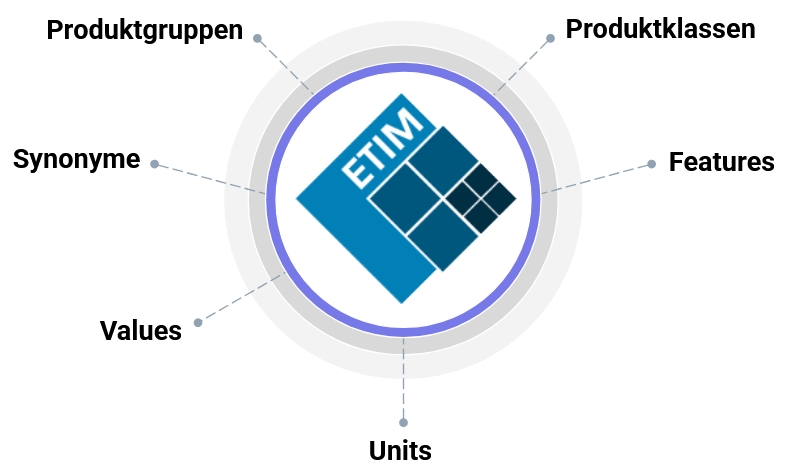ETIM
ETIM (ElectroTechnical Information Model) is an industry-wide standard for the classification and structuring of product data in the electrical and electronics sector.
Its goal is to provide a uniform and structured product description to improve the exchange of product information along the entire supply chain.
ETIM defines a hierarchical classification schema that includes multiple levels of product features and attributes. This allows for a detailed and standardized description of electrical and electronic products, including components, parts, devices, and systems.
Learn more
Why is ETIM used?
By implementing ETIM, companies achieve the following goals:
-
Efficiency: A single format for publishing and exchanging information
-
Industry Standard: ETIM is an open and vendor-neutral standard that reflects the expertise of the entire electrical industry
-
Quality: Predefined value lists and structures ensure maximum data quality across all process steps
-
Global reach & Compatibility: ETIM supports 17 languages within one model and is supported by many systems
Using ETIM improves the efficiency, accuracy, and consistency of managing and utilizing product information. It contributes to optimizing the entire value chain and helps build new international partnerships and business relationships.
For this reason, many companies — especially manufacturers, distributors, planners, and installers in the electrical and electronics industries — rely on ETIM.
Effectively using ETIM
Successfully introducing ETIM into your company and applying it consistently across all relevant channels can pose challenges due to the complexity of the standard.
Not all systems support every ETIM version or feature, let alone maintaining multiple versions simultaneously. Additionally, ETIM’s concept of group-dependent feature definitions can be difficult to implement.
prodexa offers a centralized solution that handles the full range of ETIM-specific requirements and supports multiple ETIM versions simultaneously in one system.
Learn more about how prodexa addresses the specific needs of various industries such as the electrical sector.
To get the most out of ETIM, it can be combined with other standards.
ETIM collaborates with ECLASS, and both organizations aim to harmonize their standards. Learn more about ECLASS here.
ETIM has also published its own modified version of BMEcat.
ETIM in detail

The ETIM classification model consists of two levels: product groups and product classes. Each product class belongs to a single product group.
The focus lies on the product classes and their so-called features. A class defines a group of similar products, independent of brand or supplier.
A feature describes a technical property of a product and includes a description, a type, a unit, and a value.
Possible feature types include:
- A (alphanumeric)
- L (logic/boolean)
- N (numeric)
- R (range)
ETIM Versions
Since its initial release, ETIM has been regularly updated. More on the history of ETIM.
The most important current versions include:
- ETIM Version 7.0
- ETIM Version 8.0
- ETIM Version 9.0
- ETIM Version 10.0